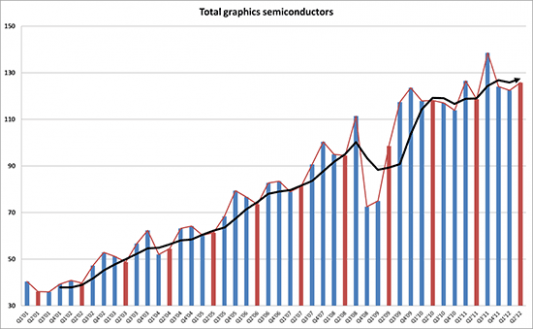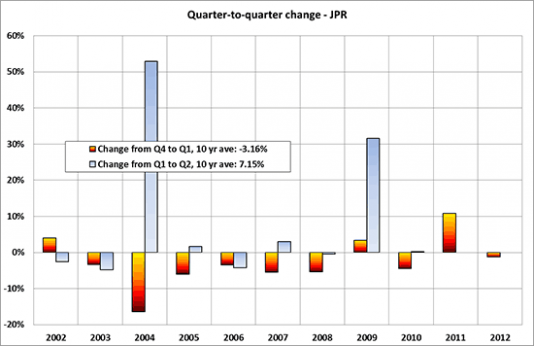Sequentially the market grew 2.5%, predicting slight growth ahead for PC market.
 Graphics chip shipments were up 5.5% in the second quarter of 2012, compared to the same quarter of 2011, according to market research released today by Jon Peddie Research (JPR). On a quarter-by-quarter basis, graphics chip shipments rose 2.5%.
Graphics chip shipments were up 5.5% in the second quarter of 2012, compared to the same quarter of 2011, according to market research released today by Jon Peddie Research (JPR). On a quarter-by-quarter basis, graphics chip shipments rose 2.5%.
Sequentially, most vendors saw shipments rise from the first quarter of 2012. Intel had gains in both desktop (13.6%) and notebook (3.8%) led mostly by Sandy Bridge. Nvidia gained in the notebook discrete segment (6%), and AMD saw gains in the discrete desktop category (2.5%).
Graphics chips are traditionally a leading indicator of the PC market, since a GPU goes into every system before it is shipped. The market includes graphics chips (GPUs) and chips with graphics (IGPs, APUs, and EPGs). At least one and often two GPUs are present in every PC shipped. It can take the form of a discrete chip, a GPU integrated in the chipset or embedded in the CPU. The average has grown from 1.2 GPUs per PC in 2001 to almost 1.4 GPUs per PC.

JPR is noting continued turmoil in the PC market, and as a result has modified it growth forecast, becoming less aggressive about the short-term prospects for sales growth in both desktops and notebooks. The popularity of tablets and the continued effects of the persistent five-year recession have altered the nature of the PC market. Nonetheless, the compound average growth rate (CAGR) for PC graphics from 2011 to 2016 is 6.3%; JPR expects the total shipments of graphics chips in 2016 to be 688 million units.
The ten-year average change for the second quarter is growth of 2.27%. This quarter is ahead of the average with a 2.5% increase.

JPR’s findings include discrete and integrated graphics (CPU and chipset) for Desktops, Notebooks (and Netbooks), and PC-based commercial (i.e., POS) and industrial/scientific and embedded. This report does not include handhelds (i.e., mobile phones), x86 Servers or ARM-based Tablets (i.e. iPad and Android-based Tablets), Smartbooks, or ARM-based Servers.
The quarter in general
AMD’s total shipments of heterogeneous GPU/CPUs, i.e., APUs (accelerated processing units) dropped 13.8% in the desktop from Q1, and 6.7% in notebooks. Ironically the company had a 55.8% increase in notebook IGPs (integrated graphics processors), but it was only 300,000 units.
Intel’s desktop processor-graphics EPG (enhanced graphics processor) shipments increased from last quarter by 6.3%, and Notebooks showed double-digit growth of 13.9%.
Nvidia’s desktop discrete shipments dropped 10.4% from last quarter; however, the company increased mobile discrete shipments 19.2% largely due to share gains on Ivy Bridge which included Ultrabooks. The company will no longer report IGP shipments.
Year-to-year this quarter AMD shipments declined 1.6%, Intel shipped almost 20% more parts, Nvidia shipped fewer parts (-22.0%) but that was because they exited the IGP segment and VIA saw their shipments slip by 18.2% over last year.
Almost 126 million graphics chips shipped, up from 122 million units in Q1 quarter, and up from 118 million units shipped Q2 2011.
Total discrete GPUs (desktop and notebook) increased a modest 0.5% from the last quarter and were down 7% from last year for the same quarter due to the same problems plaguing the overall PC market: continued HDD shortage, macroeconomics, softness in western European markets, and the impact of tablets. Overall the trend for discrete GPUs is up with a CAGR to 2015 of 5%.
Ninety percent of Intel’s non-server processors have graphics, and over 68% of AMD’s non-server processors contain integrated graphics.
Year to year for the quarter the market increased. Shipments increased to 126 million units, up 7.1 million units from this quarter last year.






